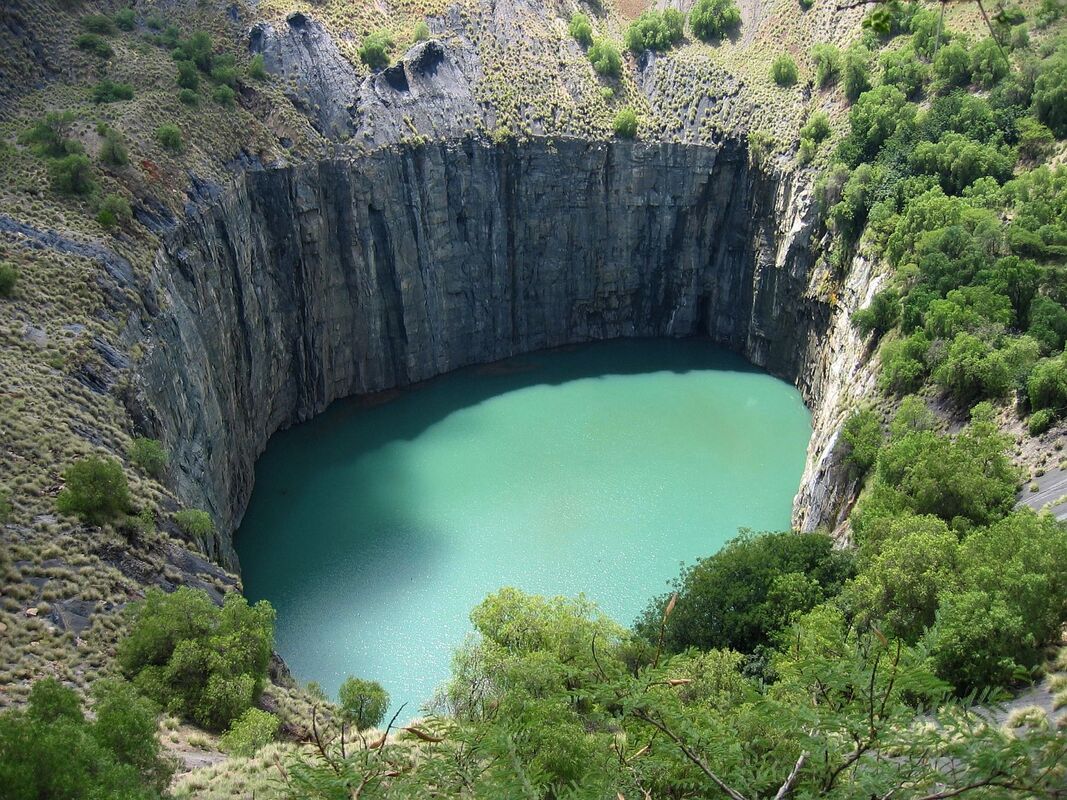Deep and Wide
By Nita Gilger
January 28, 2023
The Big Hole or the Kimberly Mine in the Northern Cape of South Africa now has a museum and tourist attraction facilities funded to the tune of 50 million dollars by the DeBeers Company known for their diamonds. Back in 1973 when I was there, none of those amenities where available. I gazed into this massive hole and began to understand its creation and its checkered history. I toured gold mines, diamond mines, and coal mines in that mineral rich country with both awe and consternation. It was then that I began a life-long curiosity and concern in wondering deeply about how we assign value and care for fellow human beings and the earth.
The frenzy and fury over diamonds began in South Africa in 1871 where this particular massive dig for diamonds was done by pick and axe and 50,000 men producing 14,504,566 karats of diamonds. The hole covers 42 acres. It is 1,519 feet wide and 790 feet deep. Yes! Hand-dug and massive.
The purpose of this reflection is not to go into the history, ecology, and politics of South Africa, but to think about what we value, how we live, and how we survive. Why have cultures both ancient and modern valued diamonds so much? And gold, and ivory? Durability? Beauty? It is true that diamonds are the hardest substance known to humankind. They have unrivaled thermal conductivity and inertness. The word diamond comes from Greek meaning 'unbreakable'. Thought to have been formed between one and three billion years ago, diamonds are one of the oldest substances known to us. Diamond formation is a scientist's dream come true when studying the geology and inner workings of the earth. Their formation begins in the center of the earth and relies on extremes of heat and pressure followed by a volatile ascent through ancient volcanoes and therefore embedded in rocks spewed upward. So, diamonds are rare and there are only a few mines in the entire world--maybe 30.
Sometimes life gives us more than we bargain for or could have ever imagined--both good and precious and challenging and heartbreaking. Finding the beauty and gifts of life takes time, care, and awareness. I believe that perhaps God is always inviting us to find and co-create beauty and share it with all those around us. But sometimes life has a kind of tragic beauty too. Beauty can and does include suffering.
Author and Minister, Patricia Adams Farmer says it this way:
Our sufferings and the sufferings of the world are shared by Love incarnate who is present in every moment, every sigh, every spasm of pain in the tiniest of creatures. This Presence is not the author of suffering, but the Sharer of suffering--the source of transformation, healing, and resurrection possibilities. This means that instead of our simply suffering and getting released from it, we become something new in the process. We die and are reborn inside the Great Sadness. We experience what Process Theologians often refer to as "creative transformation".
Perhaps diamonds can teach us something about the value of depth, time, pressure, durability, strength, and searching. Beauty is in the eyes of the beholder in many ways. But is it possible that beauty can hold sadness and trials as well?
Sharyn Marsh is a poet and educator. Her poem speaks honestly of pain and moving toward transformation:
after the dark
I long to be who I was before
Before the heartache
I wasn't prepared for this
No one ever is
I do not recognize myself anymore
buried beneath the weight
of this grief
I tell myself that this is how
diamonds are made,
in the dark, with time
and immense pressure
God's love is much deeper and wider than the Kimberly Mine. God, as our companion, walks with us through all times and all of life. Such love is far more beautiful and stronger than a diamond. As we are formed, we are not alone in the cauldron of life. We are, in fact, invited into a dance of creative transformation through it all. In that, I find rest, renewal, and hope.
